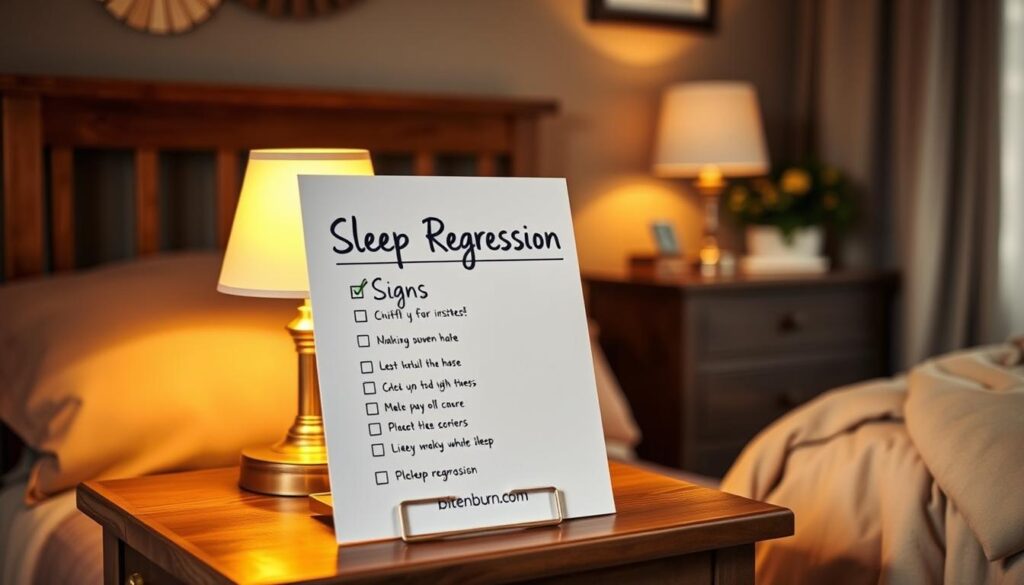Nearly 40% of families with young children report disrupted nighttime routines during developmental leaps, according to pediatric research. These phases often leave parents questioning their approach while navigating emotional strain for everyone involved.
What many don’t realize is how deeply these temporary shifts affect daily life. Changes in rest patterns can amplify stress levels, test patience, and create cycles of frustration. We’ll unpack why these moments matter far beyond bedtime.
Our focus extends to practical solutions that preserve family harmony. By recognizing signs early, caregivers can reduce anxiety and foster resilience. Small adjustments often yield significant improvements in mood and energy for all.
Key Takeaways
- Developmental phases temporarily alter rest cycles, requiring adaptable strategies
- Family dynamics benefit from proactive communication and shared routines
- Distinguishing typical changes from red flags prevents unnecessary worry
- Practical tools exist to address both immediate challenges and long-term well-being
- Realistic timelines help maintain perspective during transitional periods
- Professional guidance offers tailored support when standard approaches fall short
Understanding the Developmental Causes
Developmental leaps in early childhood create fascinating yet challenging transitions. Physical growth, cognitive advancements, and emotional maturation often collide during key developmental windows at 12, 18, 24, and 36 months. These periods reshape daily rhythms as young minds and bodies prioritize new skills over established routines.
Physical and Mental Growth Factors
Emerging abilities like walking or climbing demand intense brain activity. The American Academy of Pediatrics notes that neural pathways for motor skills develop fastest during sleep, explaining why practice sessions might replace rest. Teething discomfort often peaks alongside these surges, creating layered challenges.
Language explosions and memory formation further complicate nighttime patterns. As vocabulary expands, children frequently rehearse words during light sleep phases. This natural process can lead to frequent awakenings as their brains integrate new information.
Emotional Changes and Emerging Independence
The push for autonomy creates bedtime power struggles. Youngsters testing boundaries might resist routines they previously enjoyed. Separation worries intensify around age two as object permanence solidifies – caregivers’ absence becomes real rather than abstract.
Imagination development brings new fears, like shadows morphing into monsters. The CDC reports 60% of children experience nighttime apprehensions during cognitive leaps. Recognizing these connections helps families respond with empathy rather than frustration.
Recognizing Signs of Sleep Regression

Sudden changes in rest patterns often signal developmental progress, not problems. Caregivers might notice previously settled routines unraveling as children practice new skills. Key indicators cluster around nighttime disruptions and daytime resistance, creating predictable yet challenging phases.
Nighttime Wake-Ups and Nap Refusals
Frequent awakenings after midnight often accompany cognitive leaps. Parents report needing 20-40 minutes to resettle children during these phases – triple normal times. This pattern usually peaks within 3-5 nights before improving.
Daytime naps become battlegrounds as growing brains prioritize exploration over rest. Shortened sleep periods create overtiredness, worsening nighttime cycles. Consistent response strategies break this loop better than reactive approaches.
| Sign | Typical Regression | When to Consult Professional |
|---|---|---|
| Night Wakings | 2-3 times nightly for ≤2 weeks | Lasting >4 weeks with crying |
| Nap Resistance | Skips 1-2 naps weekly | Complete refusal for >10 days |
| Clinginess | Bedtime protests | Panic attacks or vomiting |
Separation worries often surface through repeated requests for comfort items or extra hugs. These behaviors typically align with new independence milestones. Tracking symptom duration helps distinguish temporary phases from persistent issues needing specialist input.
Identifying Environmental and Routine Challenges
Young children thrive on predictability, but life’s inevitable shifts often disrupt their rhythms. Major transitions like starting daycare or welcoming siblings create ripples in daily patterns. Even minor schedule adjustments can amplify stress during vulnerable phases.
Navigating Life’s Shifts
Household changes – from travel to illness – frequently trigger rest disruptions. A recent study found 78% of children experience sleep interruptions during room transitions. Environmental factors like temperature swings or inconsistent lighting compound these challenges.
| Factor | Ideal Condition | Quick Adjustment |
|---|---|---|
| Temperature | 68-72°F | Use sleep sacks |
| Lighting | Dim amber tones | Install blackout curtains |
| Noise | Consistent background | White noise machine |
The National Sleep Foundation notes that cooler rooms support deeper rest cycles. Families managing multiple changes should prioritize noise control first – it’s often the easiest fix.
Major life events like potty training demand extra patience. Maintain familiar bedtime rituals during transitions to provide stability. Simple consistency helps children adapt without escalating anxiety.
toddler sleep regression and mental health

The connection between disrupted rest and emotional well-being runs deeper than most caregivers anticipate. When nighttime patterns fracture, cortisol levels rise in both children and adults, creating a cycle that impacts daytime functioning. Young minds especially struggle with emotional control when exhausted, often reacting intensely to minor frustrations.
Research reveals that just four consecutive nights of poor rest can reduce a child’s problem-solving abilities by 30%. This cognitive dip frequently manifests as clinginess or hyperactivity during daylight hours. Parents facing prolonged challenges report 3x higher stress levels compared to those navigating brief regressions.
| Symptom | Typical Duration | Action Needed |
|---|---|---|
| Mood swings | 2-3 weeks | Monitor for improvement |
| Appetite changes | 5-7 days | Consult if persistent |
| Social withdrawal | Beyond 10 days | Professional evaluation |
Persistent exhaustion amplifies existing anxieties in developing minds. A 2023 APA study found children with recurring rest issues show 40% more separation fears than peers. Caregivers should watch for prolonged disinterest in play or drastic routine resistance.
Balancing consistency with flexibility proves crucial. While maintaining predictable bedtime rituals, allow extra comfort during tough phases. Many families find success combining structured routines with calming activities like storytime or soft music.
Addressing Separation Anxiety in Sleep Challenges

Nighttime fears often intensify when developmental milestones collide with emotional needs. Between 12-18 months, many children experience heightened clinginess as their awareness of separation grows. This phase demands strategies that acknowledge emotional vulnerability while encouraging healthy rest habits.
Coping with New Sleep Onset Associations
Children may start relying on specific conditions to fall asleep, like parental presence or repeated check-ins. These habits can solidify quickly during anxious periods. A gradual withdrawal approach works best – reduce involvement incrementally over 5-7 nights.
“Comfort objects bridge the gap between dependence and independence, offering tangible security during transitions.”
Introduce transitional items like stuffed animals or blankets during calm daytime moments. Pair them with reassuring phrases: “Bear will stay with you until morning.” Consistency helps children trust these substitutes for caregiver proximity.
Tailoring Comfort Routines for Your Child
Personalized wind-down rituals ease bedtime struggles. Focus on activities that signal safety without creating unsustainable dependencies. Consider these evidence-backed approaches:
| Strategy | Implementation | Effectiveness |
|---|---|---|
| Predictable Goodbyes | Use identical phrases when leaving | Reduces protest duration by 50% |
| Check-In Intervals | Extend time between visits nightly | Improves self-soothing in 80% |
| Comfort Object Training | Include item in daytime play | Boosts acceptance rates 3x |
Most families see improvement within two weeks using structured yet flexible plans. Track progress through reduced nighttime wake-ups and calmer morning moods. Adjust tactics if resistance persists beyond 14 days.
Effective Bedtime Routines for Restful Sleep
Predictable evening patterns transform nighttime challenges into opportunities for connection. Families navigating developmental transitions often find success through structured yet adaptable approaches. Consistency in pre-bed activities helps young minds transition smoothly from play to rest.
Creating a Consistent Sleep Environment
Optimal conditions reinforce healthy rhythms. Cool, dark spaces with minimal distractions signal it’s time to wind down. Use blackout curtains and white noise machines to buffer household sounds.
Comfort items like favorite blankets provide tactile reassurance during this vulnerable period. Limit stimulating activities 30 minutes before lights-out – opt for quiet stories or soft lullabies instead. These small adjustments build trust in the routine while supporting natural drowsiness.


Comment: This article highlights the significant impact of temporary shifts in rest patterns on daily life, particularly for caregivers and children. It provides insightful solutions to preserve family harmony and reduce anxiety. The focus on recognizing early signs and making small adjustments is practical and helpful. However, I wonder how caregivers can effectively balance consistency with the needs of children during major life transitions? WordAiApi
[…] Boosts energy levels and mental health […]
[…] Learn how self-care practices can improve physical and mental health […]